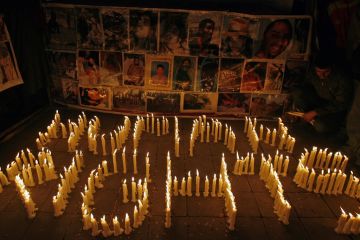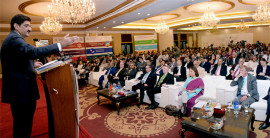
Development projects: Civil administration to brief govt lawmakers
This was stated by Sindh Chief Minister (CM) Syed Murad Ali Shah on Friday while talking to Sindh UNICEF Chief of Field Office Cristina Brugiolo, who met him at CM House to discuss the United Nations Maternal and Child Nutrition Stunting Reduction (MCNSR) programme. The meeting was attended by Planning and Development (P&D) Chairperson Mohammad Waseem, Principal Secretary to CM Sajjid Jamal Abro, Health Secretary Usman Chachar and other officials.
Shah said that the MICS project is being executed by the P&D department’s Bureau of Statistics and Rs 12.5m have already been released for the purpose. “Five rounds of MICS have been completed and now MICS-6 is going to be conducted during 2016-19,” he said. Explaining the project, he added, “MICS produces statistically sound, internationally comparable estimates of social indicators such as those required for monitoring the goals and targets of Sustainable Development Goals (SDGs) and other international commitments.”
Waseem said that MICS was going to be conducted at the national level under the coordination of Pakistan Bureau of Statistics, Islamabad with technical support from Unicef. MICS-6 will be implemented by the Sindh Bureau of Statistics, Planning & Development Department, Government of Sindh.
The purpose of conducting the MICS-6 is to provide relevant data for evidence-based planning and policy making in various socio-economic sectors. The main objectives of the MICS-6 include providing updated and reliable statistics on various social and economic indicators at households, children, women and men level in the province. It will enable the decision makers at division and district levels by providing socio-economic indicators and provide the basis for comparison of the progress in relation to various key socio-economic indicators with previous rounds of MICS.
Producing human resource: Universities can bring south out of poverty, disease
It will also establish benchmarks of those indicators which were not covered earlier for assessment of the progress on SDGs on regular basis in the province and for meeting other international commitments and provide data on 32 SDGs indicators. MICS-6 will use in depth analysis, identify gaps and grey areas in social sectors by collecting relevant data up to the district level and facilitate planners and policy makers for more effective and efficient resource allocations & evidence based planning and policy making. It will also provide data for time series analysis and cross comparisons.
The main training for collecting data on 171 indicators for several SDGs for Sindh started from October 1, 2018.
The MCNSR programme is sponsored by United States Agency for International Development (USAID) with the goal to contribute towards reduction in stunting rates by focusing on the 1000 days critical window, through a multi-sectoral approach. Consistent with this goal, Unicef will initiate nutrition-specific targeted interventions aligned with other nutrition sensitive activities in other sectors such as water, sanitation and hygiene (Wash) in various districts, including Ghotki, Khairpur and Naushero Feroze.
The Sindh government will provide necessary leadership in the health, nutrition, water and sanitation sectors to prioritise and ensure critical budget allocations.
Published in The Express Tribune, October 6th, 2018.


























1714024018-0/ModiLara-(1)1714024018-0-270x192.webp)










COMMENTS
Comments are moderated and generally will be posted if they are on-topic and not abusive.
For more information, please see our Comments FAQ